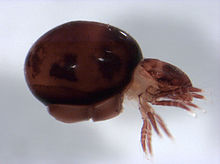by Larry
May, 2012The Many Mighty Mini-MitesMites are part of a massive array of soil fauna. These include huge numbers of dirt bacteria plus multiple arthropods (essentially small, joint-legged invertebrates with exoskeletons): springtails (entognathous hexapods); ants, cockroaches, earwigs, and beetles (insects); sowbugs (crustaceans); spiders, ticks, scorpions, and mites (arachnids); plus centipedes and millipedes (myriapods), the "giants" of this realm, often a few to several centimeters in length.
While I am focusing here on soil mites, mites specialize greatly and participate in many other ways within the natural world: bark mites; dust mites; gall mites; sarcoptic mange (mammal parasitic) mites, and so on. There are hundreds of mites associated with honeybees alone, some parasitic, others symbiotic. Soil mites may often be predators, shredders, or fungal and algae feeders. This last category includes a quite numerous soil mite, Oribatid turtle-mites, which eat the Euzetes globulus fungi. The teaming throngs of soil mites along with their other arthropod cousins perform functions essential to the creation of good quality dirt, without which many plants and animals of greater visible interest to us could not exist. For example, they reduce the size of organic matter, such as decaying plant material or rotting wood, making it bite-size for still smaller life forms. They also stir up the food pot, carrying bacteria to new nutrient sources and distributing freshly edible substances to other places. This in turn supports increased rates of decomposition. Their activity can transform the chemistry of the soil, making it easier for plants to obtain the minerals they require. By feeding on soil particles of diminishing size and pooping out progressively even smaller nutrient-rich pellets, soil mites and other soil arthropods mix the top layers of soil into an ever more tantalizing fecal feast for ever tinier denizens of soil-land, ultimately encouraging the health and reproduction of billions of bacterial and fungal forms. Mite feeding behavior stimulates a succession of smaller species to process the organic and inorganic material in soil, breaking it down with an array of enzymes, till the entire potential of the rich mulch can be realized by other forms, some of which thrive as green plants, which again use the soil for growth and photosynthesis, energized by the sun, so that the cycle begins again. Mites help control pests too. The latter, unchecked, could destroy the health of the soil. Ironically, human introduced pesticides can kill off the predator mites and other pest-reducing arthropods, making new pest outbreaks more likely. Soil mites and related dirt fauna are typically not found at great depth. The first two to four inches are most nutrient rich and vital. Larger animals' digging or burrowing and a variety of additional natural processes tend to mix the soil layers so that the benefits of healthy soil may reach the deeper roots of bigger plants such as trees. All things considered, tiny soil mites play mighty big parts in the overall health of an entire biosphere. Sources: The Living Soil: Arthropods. Andrew R. Moldenke in Soil Biology Primer; available as of 5/16/12. Soil Mites and Other Animals. Maria Minor in The Mite Lab; September 19, 2011. |
